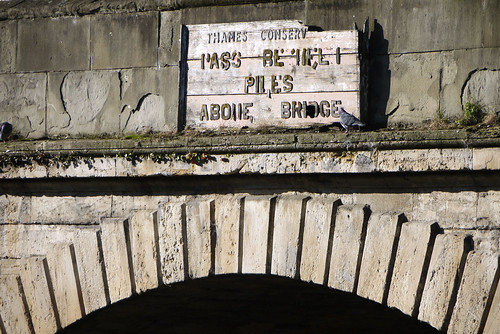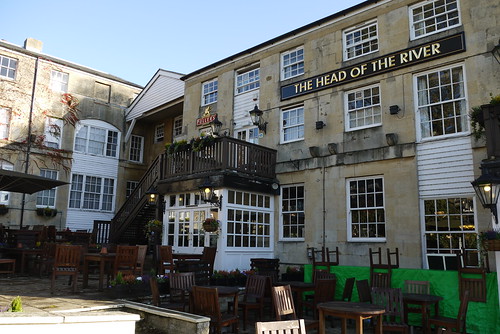The Anglo Saxon Chronicle of 912 records a settlement called Oxenford at a pace where local people would drive their cattle across the river. The popular belief has always been that the city takes its name from the words “ox” and “ford” and that the crossing place was here, at was is now Folly Bridge.
By the 11th century, the low lying lands and river were spanned by a causeway made up of a series of stone bridges, which in medieval times was called Grandpont. The bridges were maintained by charity, with hermits collecting alms at a wayside chapel. In the 19th century a railway station was opened near Folly Bridge and the Grandpont estate laid out on land reclaimed from the marshes. The name Grandpont also lives on in the riverside park whose entrance is on the far right-hand-side of the bridge.
The river here is the Isis, the name given to the Oxford stretch of the River Thames. The “Head of the River” pub takes its name from the finish of the college bumping races held during the Eights week in May. Crews of eight oarsmen race in procession trying to catch and bump the boat the boat in front and thus move up to take the title “head of the river”. The first organised race took place between Brasenose and Jesus Colleges in 1815, but other colleges soon joined in over a set course from Iffley Lock finishing here near Folly Bridge.
Salter Boatyards which operates pleasure cruises was established beside Folly Bridge in 1858. It was from here too that Charles Dodgson (better known as Lewis Carroll) set out on a rowing expedition to Godstow with Alice Liddell and her sisters, the daughters of the Dean of Christ Church. He told them stories from which the “Alice” stories were born. *
*From a sign board at Folly Bridge












We colonials sigh at such historical association.
Great presentation of the bridges around Oxford Cherie… my favorite is the one with the tram of oarsmen in the scull heading under the bridge….peter:)
It is in fact different views of one of the bridges
This is so English, Cherry, especially with the sculling boat. But I bet they wish now that the river had a different name! (sigh)
It was a pleasure to see that boat passing by
A lot of very interesting information about Oxford’s origins, Cherie – thank you
I am glad you found it interesting
Fabulous, Cherie, fabulous. Great pics, lovely read.
I am glad you enjoyed it
What a beautiful place to visit. Great pictures, love the one with the boat, we always watch the river race between Oxford and Cambridge
It was a nice place to stay too
I had lodgings near there.
We stayed in The Head of the River and thought it was a nice place
Have you been to a little village called Eynsford in Kent?

That Eynsford has a real swallow ford, and there’s a stone bridge next to the ford.
Right opposite the bridge, there’s an imposing church, making the whole scene look so beautiful. There’s also a castle in that village, Eynsford Castle (English Heritage). And it’s free to visit!
Not far away from there, there’s also another “castle” called Lullingstone Castle.
But really, it’s just a manor house. That one is not free though, non EH / NT properties either, no pictures allowed in the house. Still, it’s worth a visit. It’s the location where they filmed Compare the Meerkat TV ads.
Lullingstone Roman Villa (EH) is nearby the “castle”. I didn’t have time to see that one thou. Kent has a lot to offer.
I used to visit Kent regularly but I have never even heard of Eynsford. It sounds like a really interesting place to visit